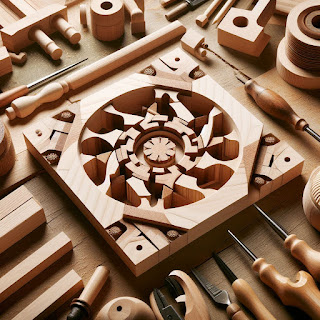From the wood joinery basics to their applications and strengths, along with invaluable tips for achieving strong connections.
Wood Joinery Basics: Building Blocks of Connection
Wood joinery basics is the cornerstone of woodworking, where pieces of wood are seamlessly connected to create strong and durable structures. Let's delve into the fundamentals:
- Butt Joint: The simplest of joints, where two pieces of wood are joined at their ends or edges. While straightforward, butt joints may lack strength and require additional reinforcement for stability.
- Mortise and Tenon: A classic joint revered for its strength and reliability. It consists of a projecting tenon on one piece fitting into a hole (mortise) in the other. Mortise and tenon joints are commonly used in furniture construction for their structural integrity and longevity.
- Dovetail Joint: Renowned for both its strength and aesthetic appeal, the dovetail joint is characterized by its interlocking shape resembling a dove's tail. This joint is often used in drawer construction, where its mechanical strength prevents the drawer from pulling apart under stress.
- Dado Joint: This joint involves cutting a groove (dado) across the grain of one piece of wood to accept the end of another piece. Dado joints are commonly used in cabinetry and shelving to create strong and stable connections between horizontal and vertical components.
Mastering these wood joinery basic methods lays the foundation for creating sturdy and well-crafted woodworking projects. Whether you're building furniture, cabinets, or decorative pieces, understanding the principles of wood joinery is essential for achieving professional-quality results.
Their Applications and Strengths: Choosing the Right Joint for the Job
Each wood joinery method possesses unique applications and strengths tailored to specific woodworking needs:
- Butt Joint: Ideal for straightforward projects or temporary connections where simplicity is key. While lacking in strength compared to other joints, butt joints are quick to assemble and suitable for non-structural elements.
- Mortise and Tenon: Renowned for its superior strength and durability, the mortise and tenon joint is a staple in furniture and cabinetry construction. Its interlocking design provides excellent support and stability, making it ideal for load-bearing structures.
- Dovetail Joint: Not only prized for its strength but also revered for its aesthetic appeal, the dovetail joint is a hallmark of craftsmanship. Its interlocking shape adds visual interest and structural integrity, making it perfect for drawer construction and box corners where both strength and beauty are desired.
- Dado Joint: Offering a snug fit and reliable support, the dado joint is commonly used for shelves, dividers, and carcass construction. By creating a groove across the grain of one piece to accept the end of another, dado joints provide strong and stable connections ideal for supporting weight and distributing loads evenly.
Understanding the characteristics and strengths of each wood joinery method empowers you to choose the right joint for your woodworking project. Whether prioritizing functionality, strength, or aesthetics, selecting the appropriate joint ensures the success and longevity of your creations.
Tips for Achieving Strong Connections: Nailing Down Success
Now that you've got the basics of wood joinery under your belt, let's ensure your joints stand the test of time with these invaluable tips:
- Precision is Key: The foundation of a strong joint lies in precision. Take your time to accurately measure and cut your joints for a snug fit. A well-fitted joint not only enhances strength but also ensures a seamless and professional-looking finish.
- Glue Matters: Don't underestimate the power of quality wood glue. Invest in high-quality glue specifically formulated for woodworking applications. Apply glue generously to the mating surfaces of your joints, ensuring full coverage for maximum bonding strength. Proper gluing not only strengthens your joints but also helps prevent future loosening and instability.
- Reinforcement: For added stability, consider reinforcing your joints with additional fasteners such as screws, dowels, or biscuits. These reinforcements provide extra support, especially in load-bearing applications where strength is paramount. Choose the appropriate reinforcement method based on the specific requirements of your project, ensuring a solid and secure connection that can withstand the test of time.
- Practice, Practice, Practice: Like any skill, mastering wood joinery basics takes practice and patience. Don't be discouraged by initial setbacks or imperfect joints; instead, view them as opportunities for growth and improvement. Take the time to refine your techniques, experiment with different joinery methods, and learn from both successes and failures. With dedication and practice, you'll steadily build your proficiency and confidence in creating strong and enduring connections in your woodworking projects.
By incorporating these tips into your woodworking repertoire, you'll be well-equipped to achieve strong and enduring connections in your projects, ensuring both functionality and longevity in your craftsmanship.
So, fellow woodworkers, are you ready to elevate your craftsmanship with the art of wood joinery? Dive in, experiment, and let your creations stand as testaments to your newfound skills. Happy woodworking!
Leave a comment below sharing your favorite wood joinery method or any tips you've found particularly useful in achieving strong connections. Let's learn and grow together! Also, you may want to visit my official Facebook page Dosefornia Furniture , and check out my new projects and the journey.







No comments:
Post a Comment